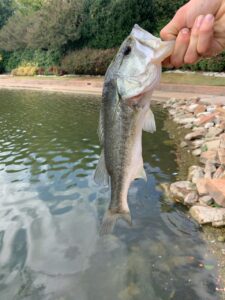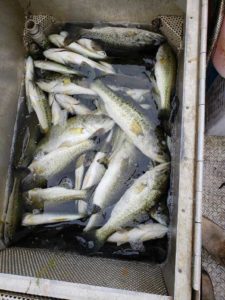How many times have you encountered the sign “Catch and Release Only” at your local fishing hole? This regulation is the most common fisheries management tool enforced on small ponds and lakes. Catch and Release programs caught on in the mid 1970’s as a good faith effort to conserve the fisheries resource in many of our public lakes and reservoirs in Texas. The idea of catch-and-release programs is to allow anglers the future opportunity to catch that 10 pound trophy again. However, the catch-and-release mindset has carried into many situations where it is actually counterproductive to the health of the fishery – the local 1 acre pond for example.

Stunted Bass From Community Pond
Largemouth bass are generally the top predator in these small lakes and ponds. They reproduce every spring and each female can lay up to 20,000 eggs in a single season! A small percentage of these eggs actually hatch and survive to adulthood; however, that is still a lot of mouths to feed. A general rule is that a bass needs approximately 10 pounds of forage to add 1 pound of body weight. Without adequate forage, the bass will become malnourished and the population will become “stunted”. The result is a pond full of overcrowded 8-12 inch bass that may never reach 15 inches in their lifetime. Another tell-tale sign of overcrowded bass is when the majority of the bluegill are very large. This is because there are very few bass in the pond large enough to eat them. This situation is fine if you just enjoy “catching” bass, but if you want quality fishing, measures will need to be taken to correct the problem.

Undersized Bass Culled Using Electrofishing Equipment
It is generally accepted in fisheries science that as many as 25 small bass per acre should be removed from the pond annually. This practice prevents “stockpiling” of smaller bass and reduces competition among the remaining bass for available food. A good rule of thumb is to periodically harvest bass measuring less than 15 inches. You should immediately release any bass caught that are 15 inches or greater. Keep in mind that the length regulation should ultimately be adjusted depending on the results of a fisheries survey and the primary goals of the angler.
“Catch-and-Release” does have its benefits in specific water bodies. However, if your local Texas fishing hole is 25 surface acres or less and it is very easy to catch undersized bass, then the catch and release mindset might be the problem.
